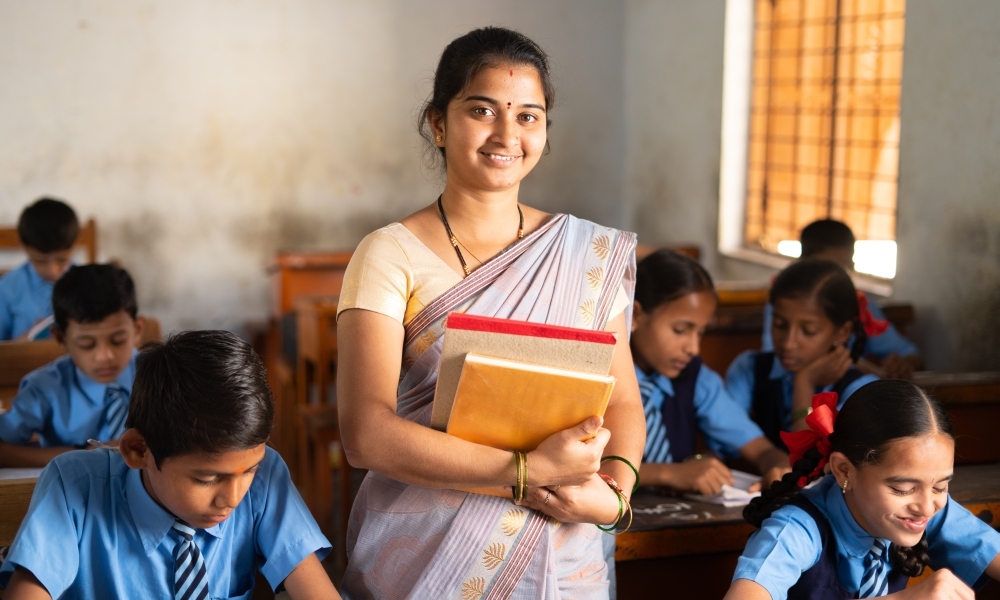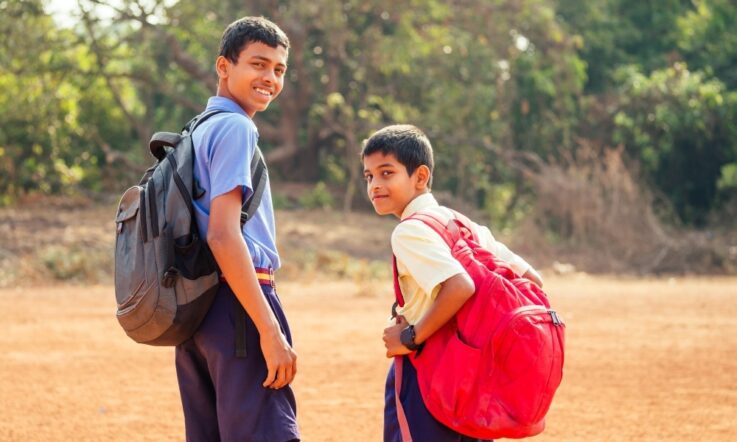Teacher is delighted to welcome Professor Vimala Ramachandran as a regular contributor. She has worked in education for more than three decades, focusing on elementary education, girls’ education and women’s empowerment. Here, she takes a look at the changing status of schoolteachers in India.
Over the last 40 years, I have moved from being an active participant in government policy and programs, to a researcher, commentator and now a bystander. Schoolteachers were always on my radar.
As the decades rolled by, teachers here in India went through periods of hope and optimism and periods of despair. From being treasured members of the community, they were repositioned as government servants who were among the last ladders in a hierarchical bureaucracy.
Then, as a large-scale elementary education program took off in different parts of the country, we saw the emergence of a new model – one which had no policy level sanction – contract teachers or para teachers (as they were called in the 1990s).
Contract teachers gained in popularity because their engagement was seen as an immediate measure to address teacher shortages by following a far simpler process of recruitment within a short time, without having to go through arduous processes of getting teacher posts sanctioned. It also helped ease the long-term liability of permanent teachers with inflation indexed salaries and pension benefits. In an era (the 1990s and 2000s) when the government was committed to enhancing enrolment of all children, bridging regional, gender and social equity gaps in elementary school participation; the practice of short-term contractual workers made fiscal sense to the government.
However, this led to the gradual decline in the social status of schoolteachers when many state governments across the country started recruiting people with minimum qualifications. The number of contract teachers in India’s education system was 6,32,316 in 2017-18 (UDISE, 2017-18). Across India one-quarter of schools have at least one teacher on contract with state wise variations in the proportions of such schools. More worrying is that 79.2 per cent of ‘small schools’, having enrolments of up to 90, function with all teachers on contract, making them the most disadvantaged (Ramachandran et al., 2020).
A good-intentioned policy that went wrong was in-service teacher training. Since the mid 1990s – when several donor-assisted elementary education programs were introduced in India – teacher training became module-based and standardised. Starting with the District Primary Education Programme (DPEP) and right up to Sarva Shiksha Abhiyan (SSA), it became practice to budget for 20 days’ in-service training for all teachers. These were rarely based on the felt-needs of teachers or on any systematic process of assessment of training needs. They were designed at the state headquarters using concepts like ‘hard spots’.
Gradually, as the years rolled by, these training programs became mechanical. Teachers found little value in them and often joked about it (Ramachandran et al., 2018). The education system also took it as something routine and not as an intervention to enhance the knowledge and skills of teachers. The Comptroller and Auditor General of India flagged the shortcomings in teacher training time and again (CAG Performance Audit Reports 2006, 2017).
The third worrisome trend that came to light over the decade of the 2000s was the quality of teacher education institutions, the sudden mushrooming of private institutions and the problem of fake degrees.
To address the problem of the ‘real’ knowledge and skills of teachers, the Right to Education Act of 2009 introduced teacher eligibility tests (TETs) as a mandatory qualification to be hired as a schoolteacher. This was widely welcomed across the country, even though states like Tamil Nadu had had an entry level examination for the recruitment of teachers for over three decades (Ramachandran et al., 2018).
However, there was a strange twist in this tale too! In 2011, barely 6 or 7 per cent of candidates were able to clear the teacher eligibility test. For example, in Tamil Nadu in 2021 only 19.5 per cent candidates were able to pass the test (“19.51% candidates clear Teachers Eligibility Test”, 2021). In Maharashtra in 2018, 5.57 per cent passed the test (Gaikwad, 2020).
The situation in some states is believed to be so bad that less that one per cent of candidates were able to pass the test. As a result, in states where there are huge vacancies, the government has been facing an uphill task to recruit teachers. Despite the challenges, it is believed that the quality of teachers recruited after the introduction of TET has improved.
The fourth related issue has to do with the system of teacher recruitment. There is a huge backlog in recruitment and at the same time there are also significant number of surplus teachers (Datta & Kingdon, 2021). This paradox has a lot to do with how teachers are deployed.
Researchers have argued that well-connected schools and those in urban areas have teacher surpluses, while remote and rural schools have many vacancies. Datta and Kingdon have shown that one cannot equate teacher vacancies with teacher shortages because of the following important reasons: (a) the prevalence of teacher surplus schools versus teacher deficit schools is not taken into account when vacancies are calculated; (b) over the last few decades the issue of fake enrolment has been recognised as a serious issue; and (c) demographic changes leading to shrinking of child population and the enrolment of more children in private schools have effectively ‘emptied out’ many government schools (Datta & Kingdon 2021).
Another related unresolved issue has to do with teacher absenteeism and proxy teachers. While some scholars have argued that this remains a serious issue, a 2017 study by Azim Premji University argued that only 2.5 per cent of teachers absented themselves ‘without reason’ and the majority of teachers who were not found in school were out on government duty or approved leave. (Research Group, Azim Premji Foundation, 2017).
The phenomenon of proxy teachers is a little more complicated and recently the Prime Minister of India asked schools to place a framed photograph of the appointed teacher in order to address the proxy teacher problem. The debate on teacher availability, vacancies, shortages and absence have remained politically charged and highly contentious.
Finally, through the COVID-19 lockdown, schoolteachers worked on the frontline – managing camps, facilitating vaccinations, and educating communities about social distancing and a host of related issues. Teachers have been used by the government as government workers and therefore were allocated many different tasks.
This is a broad overview of some of the issues troubling schoolteachers and the school education system that have, over the decades, taken a big toll. With mounting evidence on the poor learning outcomes of children and the impact of the COVID-19 lockdown, the media and the administration are pointing their fingers on schoolteachers.
All of this has negatively impacted the social status of schoolteachers. India needs to do a lot to bring teachers centre stage again and give them respect as valued professionals.
References
CAG of India. (2006). MHRD, Department of Elementary Education, Performance Audit Report on “Sarva Shiksha Abhiyan”.
CAG of India. (2017). MHRD, Department of Elementary Education, Performance Audit Report: Implementation of the Right of Children to Free and Compulsory Education (RTE) Act, 2009.
Datta, S. & Kingdon, G.G. (2021). The Myth and Reality of Teacher Shortage in India: An Investigation Using 2019-20 Data. RISE Working Paper Series, 21/072. https://doi.org/10.35489/BSG-RISE-WP_2021/072
Gaikwad, R. (2020, January 25). 1-7% of candidates pass Teacher Eligibility Test. Mumbai Mirror. https://mumbaimirror.indiatimes.com/mumbai/other/1-7-of-candidates-pass-teacher-eligibility-test/articleshow/73600456.cms
19.51% candidates clear Teachers Eligibility Test. (2021, September 13.) The Hindu. https://www.thehindu.com/news/cities/bangalore/1951-candidates-clear-teachers-eligibility-test/article36438553.ece
Ramachandran, V., Beteille, T., Linden, T., Dey, D., Goyal, S., & Chatterjee, P.G. (2018). Getting the Right Teachers in the Right Schools: Managing India’s Teacher Workforce. The World Bank.
Ramachandran, V., Das, D., Nigam, G. & Shandilya, A. (2020). Contract Teachers in India: recent Trends and Current Status. Azim Premji University.



